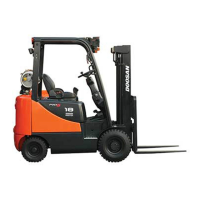A Series Diesel Engine Fuel System 80
During the injection cycle, high pressure from the
injection pump rises to the operating (pop) pressure
which causes the needle valve in the injector to lift.
Fuel is then injected into the cylinder. A shimmed
spring is used to force the needle valve closed as the
injection pressure drops belowe the pop pressure to
seal off the nozzle after injection.
Failure of the needle valve to lift and close at the
correct time or needle valve stuck open can cause
the engine to misfire and produce low power.
Fuel leaking from the open nozzle can cause a fuel
knock, poor performance, smoke, poor fuel economy,
and rough running.
Caution : Be sure to tighten the fuel line nut before
proceeding to the next injector.
To find which cylinder is misfiring, operate the engine
and loosen the fuel line nut at one injector and listen
for a change in engine speed.
Note : A drop in engine speed indicates the injector
was delivering fuel to the cylinder.
Check each cylinder until the malfunctioning
injector is found.
Remove the malfunctioning injector to test or replace
it.
If the engine continuous to misfire after replacing the
injector, check for leaks in the high pressure line.
Also check for a defective delivery valve that lets the
fuel drain back into the injection pump.

